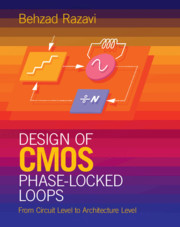Refine search
Actions for selected content:
1784 results in Circuits and systems
Part IV - SignalIntegrity
-
- Book:
- S-Parameters for Signal Integrity
- Published online:
- 18 January 2020
- Print publication:
- 06 February 2020, pp 533-536
-
- Chapter
- Export citation
Part I - Scattering Parameters
-
- Book:
- S-Parameters for Signal Integrity
- Published online:
- 18 January 2020
- Print publication:
- 06 February 2020, pp 5-6
-
- Chapter
- Export citation
3 - Scattering Parameters
- from Part I - Scattering Parameters
-
- Book:
- S-Parameters for Signal Integrity
- Published online:
- 18 January 2020
- Print publication:
- 06 February 2020, pp 41-81
-
- Chapter
- Export citation
6 - Sources
- from Part I - Scattering Parameters
-
- Book:
- S-Parameters for Signal Integrity
- Published online:
- 18 January 2020
- Print publication:
- 06 February 2020, pp 152-177
-
- Chapter
- Export citation
16 - Model Extraction
- from Part III - Signal Processing and Measurement
-
- Book:
- S-Parameters for Signal Integrity
- Published online:
- 18 January 2020
- Print publication:
- 06 February 2020, pp 512-532
-
- Chapter
- Export citation
11 - Virtual Probing
- from Part II - Applications
-
- Book:
- S-Parameters for Signal Integrity
- Published online:
- 18 January 2020
- Print publication:
- 06 February 2020, pp 319-354
-
- Chapter
- Export citation
Abbreviations
-
- Book:
- S-Parameters for Signal Integrity
- Published online:
- 18 January 2020
- Print publication:
- 06 February 2020, pp xvi-xvi
-
- Chapter
- Export citation

Design of CMOS Phase-Locked Loops
- From Circuit Level to Architecture Level
-
- Published online:
- 05 February 2020
- Print publication:
- 30 January 2020
-
- Textbook
- Export citation
Index
-
- Book:
- Design of CMOS Phase-Locked Loops
- Published online:
- 05 February 2020
- Print publication:
- 30 January 2020, pp 486-492
-
- Chapter
- Export citation
3 - Design of Inverter-Based Ring Oscillators
-
- Book:
- Design of CMOS Phase-Locked Loops
- Published online:
- 05 February 2020
- Print publication:
- 30 January 2020, pp 64-102
-
- Chapter
- Export citation
13 - Clock and Data Recovery Fundamentals
-
- Book:
- Design of CMOS Phase-Locked Loops
- Published online:
- 05 February 2020
- Print publication:
- 30 January 2020, pp 404-427
-
- Chapter
- Export citation
1 - Oscillator Fundamentals
-
- Book:
- Design of CMOS Phase-Locked Loops
- Published online:
- 05 February 2020
- Print publication:
- 30 January 2020, pp 1-33
-
- Chapter
- Export citation
6 - Advanced Oscillator Concepts
-
- Book:
- Design of CMOS Phase-Locked Loops
- Published online:
- 05 February 2020
- Print publication:
- 30 January 2020, pp 178-208
-
- Chapter
- Export citation
Acknowledgments
-
- Book:
- Design of CMOS Phase-Locked Loops
- Published online:
- 05 February 2020
- Print publication:
- 30 January 2020, pp xiv-xv
-
- Chapter
- Export citation
4 - Design of Differential and Multiphase Ring Oscillators
-
- Book:
- Design of CMOS Phase-Locked Loops
- Published online:
- 05 February 2020
- Print publication:
- 30 January 2020, pp 103-137
-
- Chapter
- Export citation
14 - Advanced Clock and Data Recovery Principles
-
- Book:
- Design of CMOS Phase-Locked Loops
- Published online:
- 05 February 2020
- Print publication:
- 30 January 2020, pp 428-452
-
- Chapter
- Export citation
5 - LC Oscillator Design
-
- Book:
- Design of CMOS Phase-Locked Loops
- Published online:
- 05 February 2020
- Print publication:
- 30 January 2020, pp 138-177
-
- Chapter
- Export citation
12 - RF Synthesis
-
- Book:
- Design of CMOS Phase-Locked Loops
- Published online:
- 05 February 2020
- Print publication:
- 30 January 2020, pp 368-403
-
- Chapter
- Export citation
10 - Digital Phase-Locked Loops
-
- Book:
- Design of CMOS Phase-Locked Loops
- Published online:
- 05 February 2020
- Print publication:
- 30 January 2020, pp 305-345
-
- Chapter
- Export citation
Frontmatter
-
- Book:
- Design of CMOS Phase-Locked Loops
- Published online:
- 05 February 2020
- Print publication:
- 30 January 2020, pp i-iv
-
- Chapter
- Export citation
